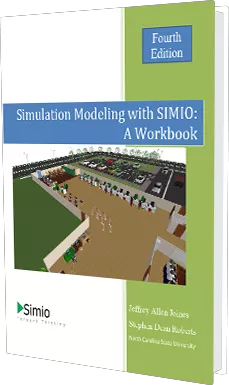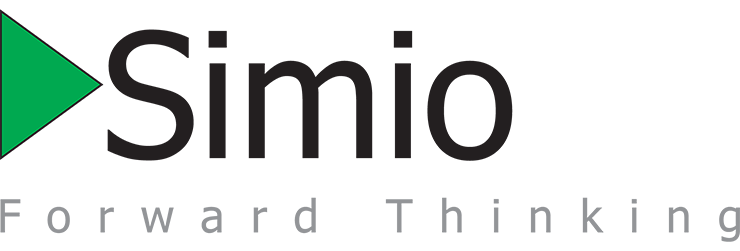Simio Publications

Simulation Modeling with SIMIO: A Workbook 4th Edition
This edition of this workbook maintains the successful “participatory” style introduced in the first edition. You don’t sit and read the book without a computer loaded with SIMIO (the book was created using version 7.124 of SIMIO™). We expect your active participation in using SIMIO as you turn the pages. We try to carry on a conversation with you. Our belief is that simulation is not a spectator sport. You have to practice to gain skill with it and you develop that skill through modeling practice. This book encourages you to practice and use your skill, and feedback from earlier editions appear to validate the approach. This book retains its focus on simulation modeling with SIMIO and most of the simulation statistical analysis and analytical issues are more thoroughly covered in other books. We strongly suggest that if you are teaching/learning simulation that you also have one of these non-language books available.
This edition of the workbook has an evolved structure based on use and experience. More emphasis is placed on “why” modeling choices are made, to supplement the “how” in using SIMIO in simulation. In Chapter 1, we present fundamental simulation concepts, independent of SIMIO which can be skipped for those who already understand these fundamentals. In Chapters 2 through 6, concentrates of the use of the Standard Library Objects in SIMIO. You can do a lot of simulation modeling without resorting to more complex concepts. A key part of those chapters is learning to identify/separate the data in a model from the model structure. Chapter 7 introduces the fundamental topic of “processes,” which we frequently employ in the following chapters. Chapters 8 and 9 concentrate on the important topics of flow and capacity. Chapter 10 introduces optimization in the context of supply chain modeling. Chapter 11 presents the influence of bias and variability on terminating and steady-state simulation. Chapter 12 introduces SIMIO materials handling features. Chapter 13 extends the use of resources while Chapters 14 and 15 describes the use of workers including the detailed services provided by task sequences and their animation. Chapter 16 details the simulation of call centers with reneging, balking, and cost optimization. Chapters 17 through 20 presents object-oriented simulation capabilities in SIMIO. Chapter 17 builds a model out of an existing model (we call it sub-modeling). Chapter 18 describes the anatomy of an existing SIMIO and in Chapter 19 we build a new object by “sub-classing” an existing object. In Chapter 20 a new object is designed and built from a base SIMIO object and its creation is contrasted with standard SIMIO object. Chapter 21 presents some of the continuous modeling features in SIMIO. Chapters 22 and 23 demonstrates the power of object-oriented simulation in the modeling supply chains and process planning respectively. We include an appendix on input modeling, although SIMIO does not provide software.
The book is designed to be read from chapter to chapter, although it is possible to pick out certain concepts and topics. Some redundancy is helpful in learning. By the time you have finished this book you should be well-prepared to build models in SIMIO and to understand the virtues of different modeling approaches.
Like SIMIO itself, this workbook has been designed for a variety of student, teacher, and practitioner audiences. For example, if you are interested in manufacturing, you will want to be sure to study data-based modeling in Chapter 5, assemply and packaging in Chapter 6, the workstation in Chapter 9, and material handling in Chapter 12. If you are interested in logistics, don’t miss modeling of distances in Chapter 3, flow and capacity in Chapter 8, inventories and supply chains in Chapter 10, and free space travel in Chapter12. If you are interested in healthcare, be sure to review scheduled arrivals in Chapter 8, resource decision making in Chapter 13, mobile workers in Chapter 14, and animated people and task sequences in Chapter 15. If object-oreinted simulation is your interest, make sure to study Chapters 17 through 20, which describes how SIMIO provides composition and inheritance to create objects. Manufacting examples and examples from the service sector are used throughout. Also we pay some attention to input modeling (including input sensitivity) and output analysis (including confidence intervals and optimization). This workbook provides comprehensive and in-depth discussion of simulation modeling with SIMIO.
At the end of most chapters, we offer commentary on topics presented. We will emphasize the strengths and weaknesses of the modeling approach and the language (we have no financial stake in SIMIO). To help insure that everyone participates in this active learning process, we sprinkled questions throughout the chapters. They have short answers and require the student pay some attention to what is going on. You can use these in class. Accordingly, even though you don’t officially take attendance, you can give credit to students who turn in their in-class assignment each day. These practices help develop a reputation as a class you need to attend. We can provide you with answers to the questions, lecture notes, homework, and tests through a shared Dropbox™ if you contact us.
Jeffrey A. Joines is an Associate Professor and the Associate Department Head of Undergraduate Programs in the Department of Textile Engineering, Chemistry, and Science at NC State University. He received a B.S. in Electrical Engineering and B.S. in Industrial Engineering, a M.S in Industrial Engineering, and Ph.D. in Industrial Engineering, all from NC State University. He received the 1997 Pritsker Doctoral Dissertation Award from the Institute of Industrial Engineers. He is a member of IEEE, IIE, ASEE, Tau Beta Pi, Etta Kappa Nu, Alpha Pi Mu and Phi Kappa Phi. His research interests include supply chain optimization utilizing computer simulation and computational optimization methods. Dr. Joines teaches graduate and undergraduate classes in computer information systems, computer based modeling in Excel and VBA, and computer simulation for Six-Sigma. Dr. Joines has also teaches industry programs in the areas of Design for Six Sigma, Simulation and Six Sigma, and Data Management to Assist in Six Sigma through the Textile Extension programs Six Sigma Black Belt and Master Black Belt program. Dr. Joines served as the Program Chair for the 2005 Winter Simulation Conference (WSC) and the Proceedings Editor for the 2000 WSC as well as developed and maintained the WSC paper management system from 2000-2009. He currently serves on the WSC Board of Trustees representing the IEEE Systems, Man, and Cybernetics Society. He has also been an author and session chair for several Winter Simulation Conferences.
Dr. Joines is involved in utilizing technology in the classroom and how it impacts problem solving. He was awarded the NC State University Outstanding Teaching Award and College of Textiles Outstanding Teacher which allowed him to become a member of the Academy of Outstanding Teachers. In 2009, Dr. Joines (along with Professor Roberts) was awarded the Gertrude Cox Award for Innovative Excellence in Teaching and Learning with Technology for Transformative Large Scale Projects.
Stephen D. Roberts is the A. Doug Allison Distinguished Professor in the Edward P. Fitts Department of Industrial and Systems Engineering at NC State University. Professor Roberts received his: Ph.D., M.S.I.E., and B.S.I.E. (with Distinction) from the School of Industrial Engineering at Purdue University. His primary teaching and research interests are in simulation modeling and health systems engineering. He has been a faculty member at NC State University since 1990, serving nine years as Department Head of the Department of Industrial Engineering and three years as Interim Director of the Integrated Manufacturing Systems Engineering Institute. Prior to serving at NC State, he was a faculty member in the Department of Internal Medicine at the Indiana University School of Medicine and the School of Industrial Engineering at Purdue University as well as the Director of the Health Systems Research Group at Regenstrief Institute for Health Care. Previously, he was a faculty member in the Department of Industrial and Systems Engineering at the University of Florida and Director of the Health Systems Research Division of the J. Hillis Miller Health Center, University of Florida. He has had sabbaticals at Wolverine Software and the University of Central Florida/Institute for Simulation and Training.
Professor Roberts is a member of Alpha Pi Mu, Tau Beta Pi, Sigma Xi, Sigma Tau, and Omega Rho and a Fellow of the Institute of Industrial Engineers. He has held Kaiser Aluminum Fellowship and a NDEA Title IV Fellowship. He received the AIIE 1967 Graduate Research Award, Outstanding Paper Award at the 12th Annual Simulation Symposium, the Pritsker and Associates Outstanding Undergraduate Teaching Award in the Purdue School of Industrial Engineering, the CA Anderson Outstanding Teacher in the NCSU Department of Industrial and Systems Engineering, the Outstanding Teacher from the NCSU College of Engineering, membership of the NCSU Academy of Outstanding Teachers, the Gertrude M. Cox Award for Transformative projects from NC State University (with Professor Joines), the Distinguished Service Award from INFORMS College on Simulation, and has served as member, Vice- Chair, and Chair of the Winter Simulation Conference (WSC) Board of Directors representing TIMS (now INFORMS) College on Simulation, and Secretary, Vice-President/Treasurer, President, and Past-President of the WSC Foundation Board. He was the Proceeding Editor for the 1983 WSC, the Associate Program Chair in 1985, and Program Chair in 1986. He has been a WSC presenter, session chair, track coordinator, and keynote speaker.
Student Resources
Coming Soon!
Other general student resources can be found in the Simio LLC Student Resources area.
Instructor Resources
Instructors who are registered to use Simio software can download slides and additional teaching materials on the Textbook Instructor Resources page.
Registered faculty members can request a login and password from textbook@simio.com.
Simio software grants and a full description of Simio’s academic program can be found in the Simio LLC Academic area.
